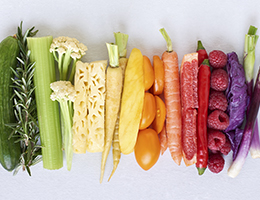
It's no secret that fruits and vegetables are packed with vitamins, minerals and other good-for-you nutrients. They don't just taste great—they help keep your body running right.
What's more, a diet rich in fruits and veggies can help lower risks for heart disease, diabetes, obesity, some cancers and other serious conditions.
Because they're so good for you, at least half your plate should be fruits and veggies.
But here's something about produce that might surprise you: Nutrients can vary depending on how you store, prepare and cook foods. With the tips that follow, you can help get the most nutrients from your produce.
Shop and store for freshness
When you select produce with care and store it properly, you can help it stay fresh longer, which can affect the nutrient quality—not to mention flavor and safety. For primo produce:
- Purchase only the amount you can use within a week. You'll ensure freshness and reduce waste.
- Avoid bruised, moldy or damaged items.
- Keep perishable produce in the refrigerator at a temperature of 40 degrees or below. Some fruits and veggies, such as bananas and potatoes, don't need to be refrigerated.
Prep and cook with nutrients in mind
Even properly stored veggies and fruits can lose some of their nutrients when you prepare and cook them.
To help retain more of your produce's peak nutrition, consider these tips from the Academy of Nutrition and Dietetics:
Wash without soaking. For safety's sake, wash produce before you use it. But don't soak it in water, which can dissolve some of the vitamins. Instead, gently rinse fragile produce, such as berries, grapes or leafy veggies, under running water without soap.
On firm produce, such as melons or cucumbers, use a soft produce brush and running tap water.
Enjoy the skin. Leave the edible skin on veggies and fruit, such as carrots, potatoes, pears, cucumbers and apples. Many nutrients are found in and just below the skin. For example, a baked potato with the skin has about twice the fiber as a potato without the skin. The skin also helps prevent nutrients from being lost during storage and cooking.
Go big. For produce with longer cook times, cut foods into larger pieces. Produce can lose nutrients when it is cut open and exposed to air or water. With fewer exposed surfaces, the larger pieces will retain more nutrients.
Avoid overcooking veggies. Heat destroys nutrients such as vitamin C and folate. You can preserve more nutrients by reducing the time that the produce is exposed to the heat. You can reduce cooking times by microwaving produce, cooking it in a covered pot or lightly stir-frying.
Cooking canned vegetables? No need to boil. Canning essentially cooks them—so you just need to reheat them.
Use water wisely. Use a steamer or only a small amount of water to prepare veggies. When you boil produce, nutrients are leeched away in the cooking water. If you do boil veggies, consider saving the water afterward. You can freeze this nutrient-rich liquid and add it to soups, stews and sauces.
When it's OK to bring the heat
Sometimes cooking enhances nutrients, according to the academy. For example, lycopene, an antioxidant in tomatoes that may provide cancer protection, is better absorbed by the body when tomatoes are cooked or processed, such as to make salsa or pasta sauce.
Vitamin A in red, yellow, orange and many dark green leafy vegetables is also absorbed by your body better when produce is cooked.
Reviewed 2/21/2024